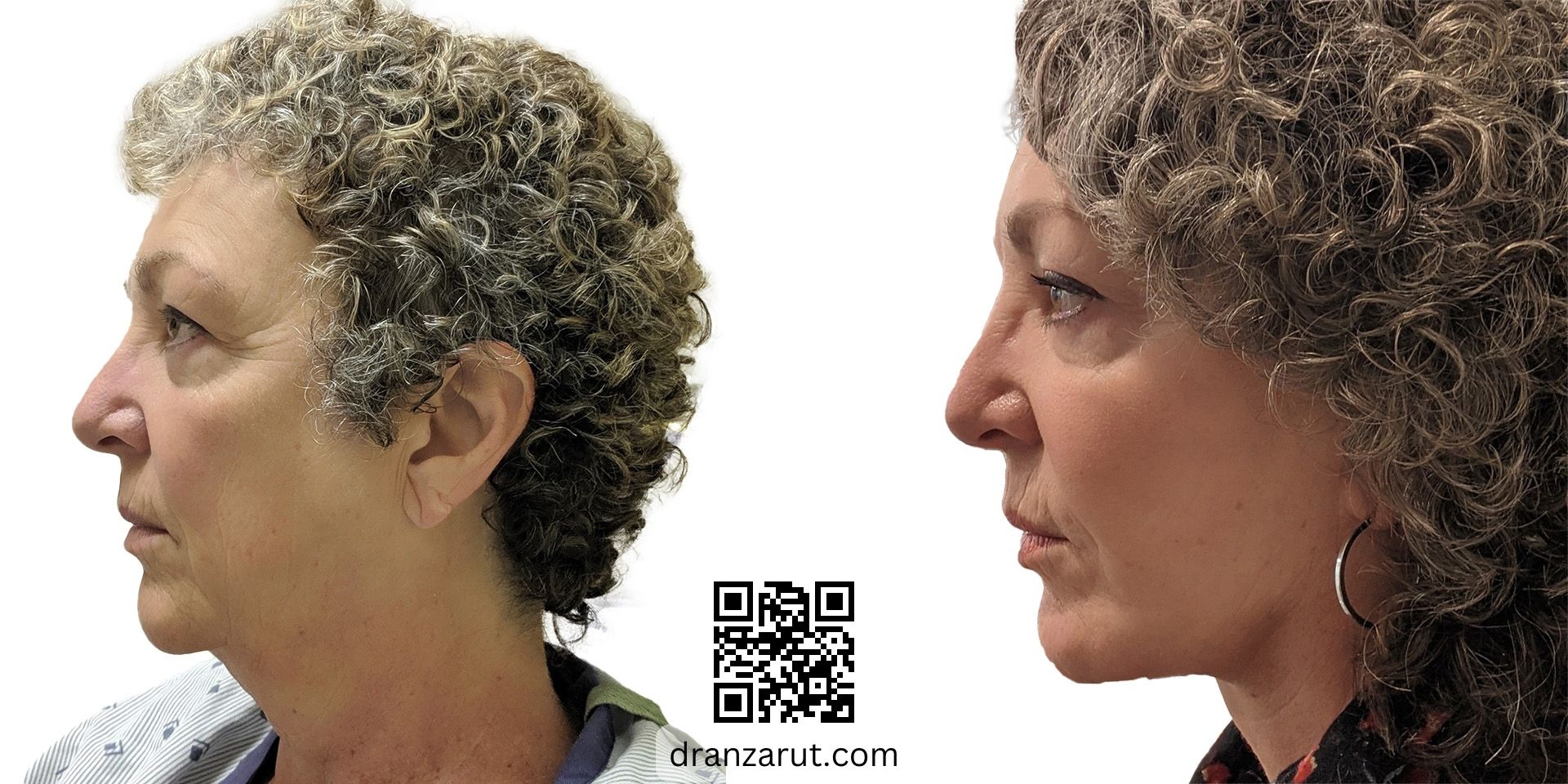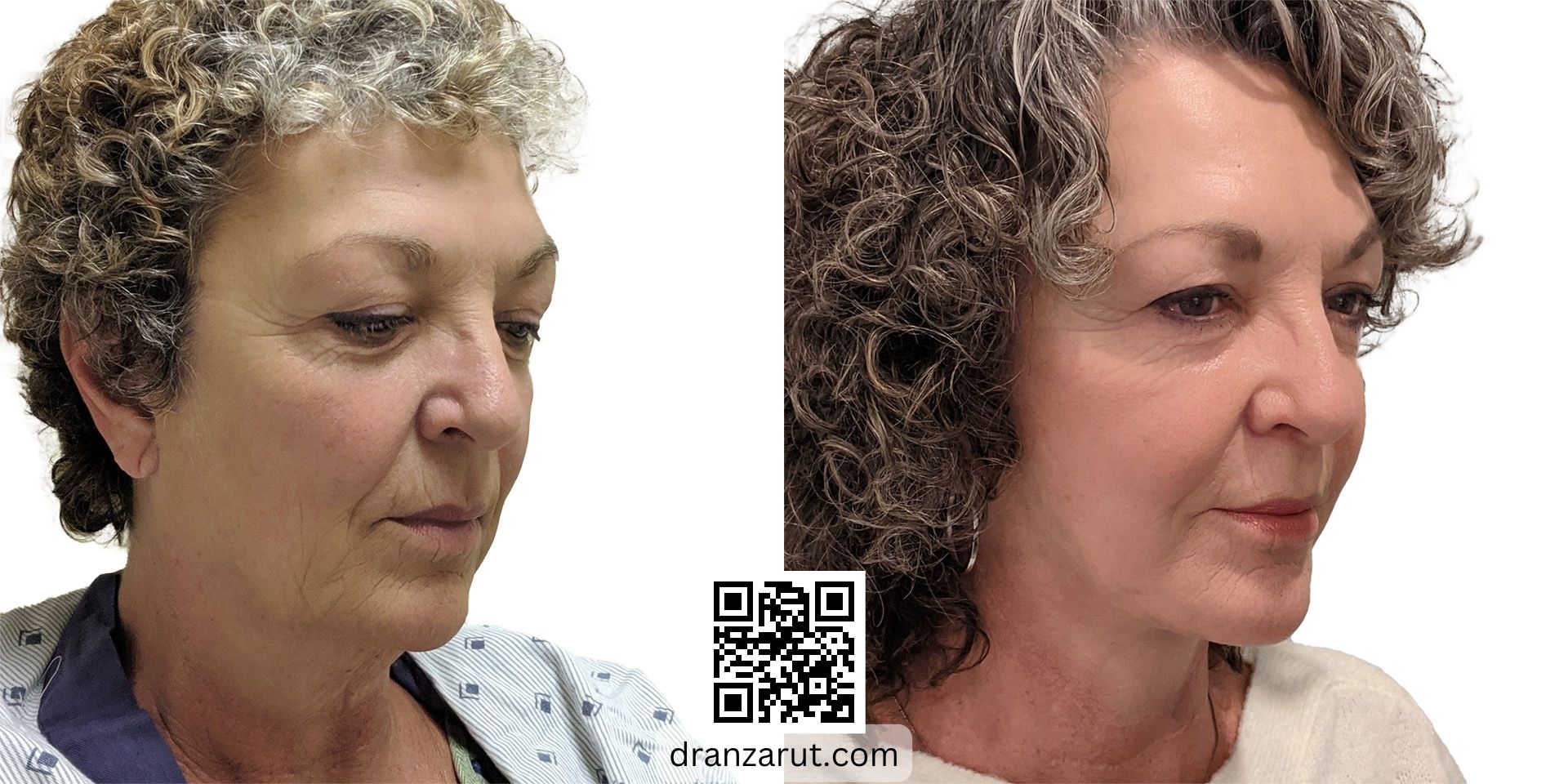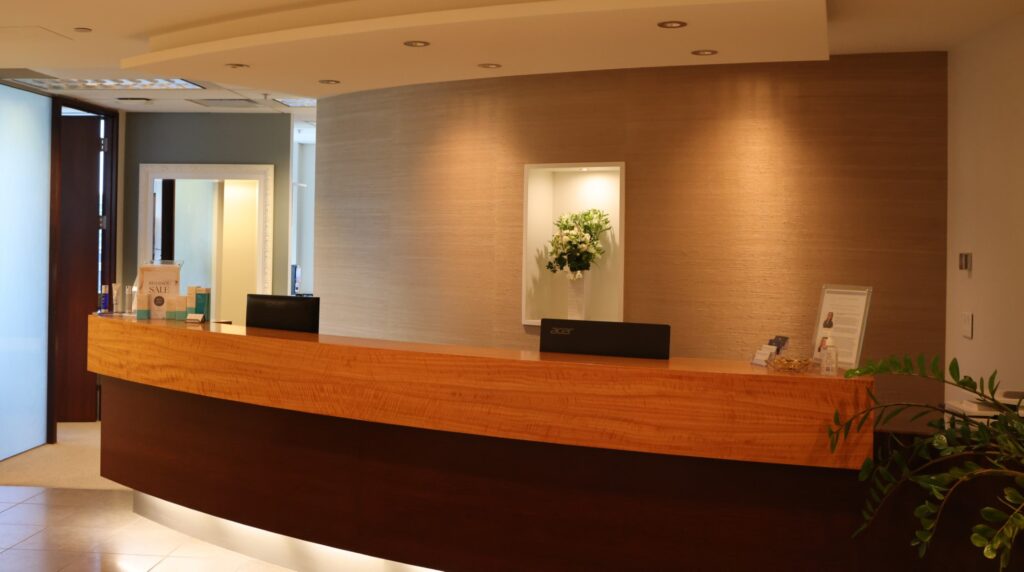A facelift (rhytidectomy) is a cosmetic procedure that helps you achieve a more youthful look.
Facelifts involves removing excess skin and fat from the neck and face, as well as tightening underlying muscles. The goal of the procedure is to create a smoother, more toned appearance while maintaining natural facial contours.
Facelift surgery can be performed both on an outpatient basis or in a hospital setting, depending on the complexity of the procedure.
The benefits of facelift surgery include improved facial features, reduction of wrinkles, and better definition of the jawline. Many patients also report an overall sense of increased self-confidence after their procedure.
However, it’s important to note that not everyone is eligible for this type of cosmetic surgery; those with medical conditions may need to get medical clearance before undergoing a facelift.
Facelift surgery has come a long way over the years in terms of safety and effectiveness, and is one of the most popular cosmetic procedures in British Columbia among men and women alike.
With the right planning and preparation, you can achieve beautiful results with minimal downtime or discomfort – making it an ideal choice for many people looking to restore their youthful glow.

Type of Facelifts
Facelift surgery is a complex procedure, and there are many different types of facelifts available.
The type of facelift you choose will depend on the area of your face that you want to target, as well as the results that you hope to achieve. Here’s a look at some of the most common types of facelifts offered.
SMAS Facelift
SMAS stands for Superficial Musculoaponeurotic System. The SMAS layer is a fibrous layer of tissue that covers the muscles of the face and connects them to the skin.
This type of facelift involves tightening the underlying muscles and tissues of the face, resulting in a more natural-looking lift.
The SMAS facelift is an excellent solution for beautiful facial skin coupled with rejuvenated and well-balanced neck and facial muscles.
Deep Plane Facelift
The Deep Plane Facelift is a more extensive procedure that targets sagging skin on both sides of the face and neck, targeting deeper muscle layers to create longer-lasting results.
This type of facelift requires larger incisions than the mini lift, with recovery typically taking several weeks or more.
Thread Lift
The Thread Lift is another option for facial rejuvenation, though it’s not as common as other types of facelifts.
It involves inserting tiny dissolvable sutures through small incisions around your face in order to lift and reposition sagging skin. The results are usually quite subtle, but they can last up to two years if cared for properly.
Mini Facelift
The Mini Facelift is one of the least invasive options for facial rejuvenation.
It involves using small incisions along the hairline and around the ears to tighten muscles and remove excess skin from the lower half of the face. This type of facelift can provide subtle improvements without drastically altering your appearance.
Ponytail Facelift
The term “ponytail facelift” is often used to describe a facelift technique that focuses on lifting and tightening the skin and muscles of the lower face and neck, resulting in a more youthful and refreshed appearance.
This type of facelift may be appropriate for patients who are experiencing sagging skin and jowls around the jawline and neck. The term may refer to the fact that the procedure aims to create a smoother and tighter appearance in the lower face and neck, similar to the effect of pulling one’s hair back into a ponytail.
It is important to note that the term “ponytail facelift” is not a standard medical term and is not recognized by all plastic surgeons.
What is the difference between various facelift procedures?
Facelifts may vary in how the SMAS layer is lifted and repositioned. The fat and gristle that is lifted during a facelift is called the SMAS.
Under some circumstances, the SMAS is left attached to the underlying muscles of the face. Examples of these facelifts include SMAS-plication, SMASectomy, and the MAX techniques.
In other circumstances, the SMAS layer is lifted off the deeper muscles of the face prior to being repositioned. Examples of these include the sub-SMAS, extended-SMAS, and high-SMAS techniques.
Some surgeons lifting the SMAS off the underlying facial muscles may provide longer lasting results. There is no evidence to support this. Lifting the SMAS off the muscles may be associated with a longer recovery, more bruising, and a higher risk of complications.
Dr. Anzarut can review the pros-and-cons of each technique to help decide which may be best for you.
What Other Procedures Can Be Combined With a Facelift?
Some cosmetic procedures are often done in combination with a face lift. Including:
- Fat Grafting – It is common to combine fat grafting with a facelift procedure. Fat grafting involves injecting fat from the abdomen to replace the fat that has disappeared with age.
- Brow Lift – In some patient with excessive forehead wrinkles, creases, and eyebrow droop a brow lift (forehead lift) is performed at the same time.
- Eyelid Lift – When patients who have age related changes of the skin and fat in the eyelid region this can be treated at the same time with cosmetic eyelid surgery (blepharoplasty).
- Neck Lift – A complete neck lift is the most common procedure that is combined with a facelift.
- Skin Resurfacing – If you have fine lines and wrinkles these may require a skin resurfacing procedure to obtain an optimal outcome.
Cosmetic Surgery Procedures (Face)
Benefits of a Facelift: Is a Facelift for me?
A facelift is an excellent choice for anyone looking to improve the look of their face and address signs of aging. It can help to achieve a more youthful appearance, restore facial volume, and reduce wrinkles, creases, and fine lines. Many men and women seek out a facelift for these reasons.
The main benefits of getting a facelift are the dramatic results it can provide. The procedure helps tighten and lift sagging skin, as well as reduce wrinkles in the face and neck area. In addition to improving the overall contours of your face, a facelift also helps give you a much more refreshed appearance.
Whether you’re looking to enhance your looks or want to restore a more youthful appearance, a facelift is one of the most effective ways to do so. With today’s advanced techniques and technology, you can expect natural-looking results that will last for years to come.

About the Facelift Procedure
Our team is committed to delivering results that exceed expectations. Our approach to each patient is individualized.
Preparing For a Facelift
Before undergoing a facelift procedure, it is important to take note of the pre-op instructions. Facelift patients should make sure they get plenty of rest and have a healthy diet leading up to their procedure. Additionally, they should avoid any strenuous activities or exercise that could affect the process.
Patients should also be aware of what medications and supplements they are taking. They should inform their doctor if they are taking any blood thinning medications or supplements as these can pose a risk during surgery. It is important not to take any aspirin, ibuprofen, or other non-steroidal anti-inflammatory drugs (NSAIDs) before surgery as these can increase bleeding during the operation.
Finally, patients should also arrange for someone to drive them home after the operation. This will ensure that they are able to get home safely and comfortably following the procedure.
What To Expect During The Procedure
Once you have completed your pre-op instructions and are ready for the facelift procedure, you’ll want to know what to expect.
During the operation, anesthetics will be used to ensure your comfort. Depending on the type of facelift being performed, all or part of the face may be numbed before work is done and incisions are made.
Your surgeon will carefully make incisions along predetermined lines in order to access underlying structures and lift tissue and muscles. Excess fat may also be removed during this time.
The next step is suturing the incision together in order to reposition the soft tissue and create a more youthful look. In some cases, additional procedures such as liposuction or skin resurfacing may also be performed during this time, depending on your individual needs.
Finally, any bandages or dressings will be applied to protect the incision site from infection and allow it to heal properly. You can expect your surgeon to provide detailed postoperative instructions before sending you home from your facelift procedure.
Post-Op Care Instructions & Recovery Time
It is essential to follow all post-operative care instructions provided by your doctor or clinic staff. Immediately after surgery, it is important to rest and take the medications prescribed by your doctor. You should also be sure to avoid any strenuous activities that could cause the wound to open or become infected.
Dr. Anzarut takes special precautions to minimize swelling and bruising. After surgery you may need to take medications for your blood pressure. Patients usually return home the same day.
To ensure a speedy recovery and limit complications, you should keep your incision clean until instructed otherwise. Also, make sure that you don’t expose the surgical area to sunlight or extreme temperatures during the healing process. It’s best to avoid swimming or bathing in tubs while recovering as well.
Be sure to attend all follow-up appointments with your surgeon so they can monitor your progress and provide additional post-operative care instructions as needed. Take any prescriptions as directed, and contact your doctor immediately if there are any signs of infection or prolonged pain in the affected area.
There may be a drain placed at the time of surgery. This is removed after 1-5 days after. Five days after surgery your sutures (stitches) will be removed. You will have some bruising and swelling. This is normal and should subside after the first 1-3 weeks.
Long Term Results
The final result of your facelift will be evident after about 12 months, depending on your skin type, the extent, and expertise of the surgery.
Once post-op care instructions have been followed and the healing process is complete, the long-term results of a facelift can be enjoyed. Patients may experience an improved facial contour and enhanced self-confidence. It’s important to keep in mind that aging cannot be stopped, but it can be slowed down with healthy lifestyle habits.
The effects of a facelift are typically long lasting, though gradual changes in skin laxity and volume will occur over time due to the natural aging process. To maintain results for longer, patients should protect their skin from environmental damage such as sun exposure. Additionally, regular maintenance treatments like light chemical peels or laser resurfacing may help minimize signs of aging.
It’s also important for patients to understand that no two faces are exactly alike and not every patient will achieve identical outcomes following a facelift procedure. However, most patients can expect to look years younger with an improved facial profile. With proper skincare and treatment regimen, the long-term results of a facelift can last for many years.
A facelift may allow you to appear 10-20 years younger, on average. Facelifts that are done at an earlier age will have a longer lasting effect. However, it won’t stop the clock and you will continue to age.
Facelift Before & After Photos



For more facelift before & after photos click the link below.
See Facelift “Before and After” Photos
Risks & Complications of a Facelift
The more informed you are about the plastic surgery procedure the happier you will be with the results.
There are some side effects and risks of facelift surgery you should be aware of. Side effects include temporary numbness or tingling of the face, bruising, swelling, and deep stitches that may be felt. Early on, the incisions will be firm and may be red. With time they will soften and the redness will fade.
Complications of facelift surgery may include small areas of permanent numbness over the ear or face, temporary or permanent injury to the nerves that allow the facial muscles to move, thick or wide scars, asymmetry, deformity of the ear lobe or hairline, infections, bleeding or fluid collections.
There are also risks associated with anesthesia itself. When performed by a board certified plastic surgeon, complications are usually minor and less common.
Non-Surgical Facelift Alternatives
Non-surgical alternatives for facelift procedures are becoming increasingly popular. These treatments offer a more natural, subtle result that can be just as effective at reversing the signs of aging.
One of the most common non-surgical facelift alternatives is dermal fillers, also known as a liquid facelift. Dermal fillers are substances injected beneath the skin, providing volume and smoothing wrinkles and lines. They can also be used to enhance facial contours and restore lost volume in areas such as cheeks and around the eyes.
Other non-surgical alternatives include chemical peels, laser resurfacing, and microdermabrasion. Chemical peels use acid solutions to exfoliate the skin, while laser resurfacing is used to reduce wrinkles and increase collagen production.
Finally, microdermabrasion is an exfoliating procedure which removes dead skin cells from the surface of the face. All these treatments provide a safe and effective way to reverse the signs of aging without surgery or downtime. Results vary depending on individual needs but generally last between 6 months to 1 year.
What Can I do to make sure I get the best result?
Before surgery it is important to avoid medication and foods that may cause bleeding or poor wound healing. Dr. Anzarut will provide you with a list of these. It is essential to avoid smoking for at least two months before and after surgery.
After surgery you should follow the post-operative instruction. Avoid submersion under water or strenuous activity for the first three weeks.
Over the longer term you should protect the skin and the incision from the sun, avoid smoking and maintain a healthy lifestyle.
How Much Does Facelift Surgery Cost?
The cost of a facelift can vary significantly depending on the complexity of procedure, the type of anesthesia, and the experience of the doctor performing it. Generally, facelifts range from $18,000 to $26,000.
The price can also depend on how much tissue needs to be addressed and which areas are being treated. For example, if you need more extensive treatment such as a deep plane facelift or a midface lift, then the cost will be higher than for a mini facelift.
In addition to the cost of the procedure itself, patients should also factor in additional costs such as preoperative testing, post-operative visits and medications. It is important to note that these costs are not typically covered by medical insurance plans and must be paid out-of-pocket.
It’s worth doing some research into reputable surgeons who offer quality services at reasonable prices. Before you book an appointment with any surgeon or clinic, make sure you read reviews from past patients and ask questions about their experience with them during your consultation so that you can make an informed decision about their services.
Watch Dr. Anzarut Explain Facelifts & Facial Aging
Why Does The Face Age?
There are multiple reasons the face ages with time. Aging affects the skin, fat, gristle, muscles and bones of the face.
Skin loses its elasticity causing wrinkles. Fine wrinkles are caused by damage to the skin. Deep wrinkles are caused by skin damage combined with repeated muscle motion.
Fat and gristle is located under the skin of the face. This layer is called the SMAS layer. Over time it drops due to the pull of gravity. Some of the fat disappears. This leads to hollowing around the lower eyelids and upper cheeks and bags around the eyes, mouth and jaw line.
Muscles in the neck cause visible bands.
Bones of the face will shrink slightly, adding to the hollowing of the upper cheeks.
Combined, the changes associated with facial aging are given names such as tear troughs, nasojugular folds, jowls nasolabial folds, and marrionette lines.
Frequently Asked Questions
A facelift is a surgical procedure that is designed to improve the appearance of the face and neck by removing excess skin and tightening underlying muscles and tissues.
Good candidates for facelift surgery are individuals who are in good health, have realistic expectations for the outcome, and are bothered by the signs of aging on their face and neck, such as sagging skin, deep wrinkles, and loss of facial volume.
There are several types of facelifts available, including traditional facelifts, mini facelifts, and thread lifts. Each type of facelift is designed to address specific concerns and can be customized to meet the patient’s individual needs.
The length of a facelift procedure can vary depending on the type of facelift being performed and the extent of the surgery. On average, a traditional facelift takes approximately 3-6 hours to complete.
The recovery process after a facelift typically takes 1-2 weeks, during which time patients may experience swelling, bruising, tingling, tightness, and discomfort. It is important to follow post-operative instructions carefully to ensure a smooth recovery.
Like any surgical procedure, facelift surgery carries risks, such as infection, bleeding, and scarring. However, these risks can be minimized by choosing an experienced and qualified surgeon.
The results of a facelift can last for several years, depending on factors such as the patient’s age, skin elasticity, and lifestyle habits. To maintain the results of a facelift, it is important to maintain a healthy lifestyle and protect the skin from sun damage.
The cost of a facelift varies depending on the type of facelift being performed, the extent of the surgery, and other factors. On average, a traditional facelift in Vancouver costs between $18,000 to $26,000. Contact us to discuss financing options.
Yes, there are several non-surgical alternatives to facelift surgery, such as Botox, dermal fillers, and laser treatments. These treatments can be effective for addressing certain signs of aging, but may not be as effective as surgery for more advanced concerns.
When choosing a facelift surgeon, it is important to look for a board-certified plastic surgeon with experience performing facelifts. It is also a good idea to read reviews from previous patients and schedule a consultation a few doctors to discuss your goals and expectations.
Dr. Anzarut will place a small drain at the time of surgery. This is usually removed after 24 hours. Without drains fluid may build up under the skin and compromise your result. In some patient, tissue sealants may be used instead of drains..
Facelift procedures can be performed using local anesthetic (freezing) and sedation or with general anesthesia.
A standard facelift will provide a modest improvement to the appearance of the neck. The addition of a formal neck lift will allow for more significant improvements in the appearance of the neck.
A formal neck lift will treat banding in the neck, improve of the angle of the neck and excess fat and skin. A formal neck lift involves lifting the skin off neck.
Patients who are in their 40s usually will not need a formal neck lift, while patients in their late 50s often have enough skin laxity to require a formal neck lift.
Facelift incisions are made along the sideburns, the ear, and the hairline. The extent of the skin incisions depend on the amount of skin laxity and type of face lift.
Patients with minimal to moderate laxity may achieve an excellent result with a small incision called a short scar face lift. If there is more laxity a longer incision may be needed to achieve the desired result.
A complete neck lift requires a small incision under the chin. Most incisions heal well and can be camouflaged with make-up if desired.







